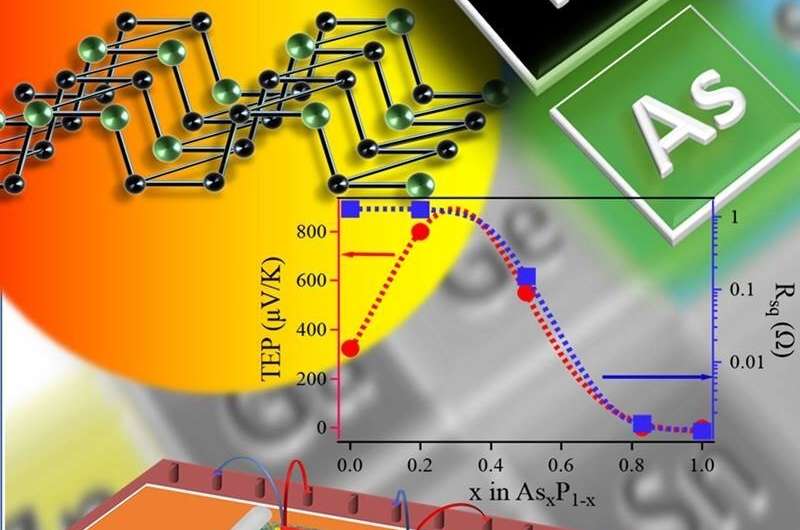Black phosphorus alloy in a temperature gradient (upper left), a thermoelectric power measurement device (lower left), and (center) a graph displaying the effect of composition on thermoelectric power (left axis) and resistivity (right axis). Credit: J. Jasinski, University of Louisville
The quest for thermoelectric materials that efficiently convert changes in temperature into electric voltage is challenging. For optimal performance, a material must conduct small amounts of heat and large amounts of electricity. However, crystal structure and electrons that carry electricity also carry heat. Researchers have identified black phosphorus (BP) as a candidate for novel applications. Doping BP with arsenic results in a two-dimensional (2D) material with a structure that may break the link between heat and electrical conductivity. In 2D layered materials, electrons are very mobile within the layers. However, weak chemical bonding between layers limits the transmission of heat between planes. This means the structure selectively reduces the transmission of heat, resulting in better performance.
Researchers have found that substituting arsenic for a few phosphorus atoms stabilizes a 2D structure in BP. This structure results in improved thermoelectric power compared to pure BP. The potential for improved conversion of waste heat into useful electrical energy makes arsenic-doped BP a much more interesting candidate than BP for energy efficient technologies.
Temperature-dependent transport measurements for various levels of arsenic doping showed that arsenic concentrations of nearly 20 percent greatly improve the thermoelectric properties of BP, resulting in comparable or even better performance than some of the most outstanding thermoelectric materials. This research studied structural changes of BP with arsenic doping and found that arsenic atoms move slightly outward with respect to the surrounding phosphorus atoms, distorting the BP crystal lattice. Distorted structures and asymmetrical atomic bonds increase the anharmonicity of a crystal, slowing down the lattice vibrations (phonons) that carry heat, thereby further reducing the thermal conductivity.
Typically, this doping has been found to reduce the electrons' mobility, with the net effect of reducing the thermoelectric properties. This does not happen in lightly doped BP samples. Here, the electronic conductivity remains sufficiently high because electrons can carry electricity by hopping through the many defects created by arsenic dopants in the crystal. This conduction mechanism realizes a balance between competing factors, enabling the material to behave like a bad conductor of phonons but a good conductor of electrons, which is key to realizing optimal thermoelectric materials. This study demonstrates that high efficiency thermoelectric materials with tuned properties may be realized by simply changing the chemical composition at the synthesis stage.
More information: Bhupendra Karki et al, Structural and Thermoelectric Properties of Black Arsenic–Phosphorus, ACS Applied Energy Materials (2020). DOI: 10.1021/acsaem.0c01172
Provided by US Department of Energy
























